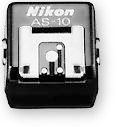 |
Other applicable secondary Flash / Camera features: AF-Assist Illuminator |
. |
Repeating Flash The repeating flash features is WORKABLE on all Nikon models. In the "mode, the SB-28 fires repeatedly during a single exposure, creating stroboscopic multiple-exposure effects. This mode is useful when shooting fast-moving subjects. This strobo-effect operation is selectable with the Speedlight SB-26, in which the flash fires continuously at selected rates; you can choose the length of time between flashes (1 Hz to 50 Hz), the number of flashes and the flash output amount. |
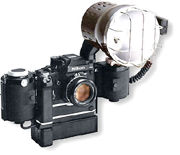 |
Previously, Nikon does offered a specialized Repeating Flash called Nikon SB-6, subsequent handle/bracket-mount flash such as SB-11 and SB-14 also offer similar feature. Repeating flash requires the core flash to have enough raw power to enable it to function effectively, the normal way is used via auto flash. Subsequent Nikon flash such as the TTL-capable MF SB-15 (too weak to use unless the flash working distance is close enough) while the more powerful MF SB-16 does offers reasonably good working distance in TTL mode. The SB-6 is a different beast. It can provide strobe operation can emitting up to 40 flashes per second, and you have the ideal high-powered unit for cine 18 or 24 fps or extra-rapidly moving subject, stop-action photography. |
Essential Notes on Flash Photography with Nikon F5: * Nikon advises only Nikon Speedlights are encouraged to use with the Nikon F5 and they claim other third party labeled units may damage the camera's electrical circuits due to incompatible voltage requirements*, electric contact alignment or switch phase. *1 Not compatible with 250V or higher. * When using a special Speedlight, such as a studio strobe system, with a time-lag provision or one with a long flash duration (i.e., Medical-Nikkor 120mm f/4 *2), adjust the shutter speed down to 1/125 sec. or slower (*2note: Medical Nikkor( 120mm P is not available in EU countries) * SB-26 can be used for multiple flash photography in its wireless mode. See Speedlight instruction manual for details. * When the center focus area is not selected, AF-assist illuminator does not light.
For multiple
flash photography with the F5, if the electric current in the synchro circuit
exceeds a certain level, you may not be able to take a second shot. Take care that
the combined total of the coefficient (numbers shown in parentheses below) for all
Speedlights used at any one time does not exceed 20 at 20° C (68°F) or 13 at 40° (104° F').
| SB-28 (1) SB-27
(1) SB-26 (1) SB-25 (1) SB-24 (1) SB-23 (4) SB-22s (1) SB-22 (6) SB-21 (4) SB-20 (9) SB-19 (2) SB-18 (16) SB-17 (4) SB-16 (4) SB-15 (4) SB-14 (1) SB-12 (1) SB-11(1) |
NOTE: If you are unable to take a second shot, disconnect the master Speedlight from the camera, or turn each of the Speedlights off and on. This resets the circuits so you can resume shooting. This also applies when using any non-Nikon studio Speedlight system. |
  |
Warning: For multiple flash photography using Nikon Speedlights, if the electric current in the sync circuit exceeds a certain level. you may not be able to take a second picture after taking the first. Take care that the combined total of the coefficients (numbers shown in parentheses below) for all of the Speedlights used at any one time does not exceed 20 at 20'C/68*F (13 at 40 C/104 F). |
Various Nikon AF-Speedlights SB-28, SB-27 and SB-26 & older models
NOT ALL Nikon speedlights can fully take advantage of Nikon F5's incredible features in flash photography. However, a great advantage of getting a Nikon-labeled speedlight is, one way or another, each of these flash can be used freely with a Nikon directly or indirectly. The missing link could be just confined to individual camera model's incorporated feature(s). For an instance, you can still use your trusty oldie such as the manual focus Nikon SB-16B onto the Nikon F5 but still retaining all features the flash can provide rather than restricted by camera's function.
 |
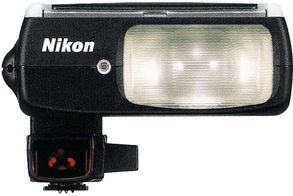 |
As Nikon has a long history in developing dedicated speedlights for their SLRs, although chances are RARE that you may be using your Nikon F5 with one of those old units, buts still, if you are very interested in getting to understand what those oldies can help your camera, you can find out from the MF Nikon FLASH RESOURCE Section which covers models from the aged bulb-flash units, SB-1 to SB-21. The AF-Speedlight Section which started from Nikon AF-Speedlight SB-20 to SB-30 (EXCEPT the DX-Series originally designed for the Nikon Digital SLRs which I require sometime to study the main difference between them). |
When the Nikon F5 was announced back
in 1996, the press release stated companion flash for Nikon F5 was SB-26/27 which
aimed to serve as either as high performance or highly portable compact options.
Both models fully optimize all possible flash functions with the Nikon F5. Nikon's
SB-26 Speedlight boasts
a powerful guide number of 36 (ISO 100, m; with zoom head set at 35mm). It offers
such advanced features as Monitor Pre flash, Repeating Flash for dramatic strobe
effects and FP High-Speed Sync, which enables the use of a shallow depth of field
in bright daylight. Moreover, it's easy to configure, a Wireless Slave Flash using
two or more SB-26s. And the built-in AF-assist illuminator provides the F5 with autofocus
capability even in total darkness. You can rotate and tilt the flash head for bounce
flash photography, and flash coverage automatically adjusts for any focal length
from 24 to 85mm. The built-in wide flash adapter even extends coverage to 18mm or
20mm. Flash output level compensation and manual flash control are also possible.
There's even a built-in bounce card to produce catch-light effects.
On the other hand, the far compact Nikon Speedlight SB-27 offers a guide number of 30 (ISO 100, m; zoom
head set at 35mm), Monitor Pre-flash, AF-assist illuminator, automatic zoom flash
covering 24mm to 50mm, built-in diffuser card and bounce flash adapter. Both speedlights
are very well made units and have sturdy exterior construction to last for heavy
duty usage. The SB-27 remained in production even after the SB-28 replaced the SB-26
simply because its compact and highly portable fashion (plus its modest price as
compared to other high performance units).
 |
 |
However, the followed model which designed to replace the SB-26, Nikon SB-28 AF-Speedlight was a redesigned model with a far compact dimension than earlier models. Weighing only at 320g (approx. 11oz), the weights reduction is nearly 30% lighter than all predecessors. The has a flat panel design at its rear section where the LCD and control buttons locate is cleaner and less cluster than previous Nikon flash model(s). |
Flash exposure control: TTL automatic flash: TTL automatic flash control with F5, F100, F80 series, Nikon F4 series, F90x, F70, F-601, or F-50 ; non-TTL automatic control with any Nikon SLR (with Flash Unit Coupler AS-4, TTL-AS-7 and/or AS-17 required with Nikon F3-series). Manual control: full 1/2, 1/4, 1/8, 1/169 1/32 and 1/64 output.
The introduction of the Nikon D-Series SLR bodies has created some technical difficulties for obtaining similar performance for flash with Nikon film-based SLRs. Basically, as digital SLRs employ NO shutter blade and in order to emulate the principle of TTL-OTF (Through the lens-Off the Film Plane) flash exposure as with film based SLR, Nikon D-Series bodies use a shutter blade located in front of the CCD sensor. This allows TTL monitoring of the pre-flashes just before exposure and even after the reflex mirror goes up. The differences would require Nikon to redesign the SB-28 in order to optimize the way how it works in a digital SLR. Flash performance and operation for BOTH SB-28 and SB-28DX are similar in nature except how the flash exposure works when mounted onto a different camera model. The effect of flash with respective medium (film/digital)will be explained below but such classification also has confused many users. Fortunately, the newer Nikon speedlight such as SB-30 eliminates this confusing state and can be used with either of the medium.
|
|
|
Camera Group |
I |
II |
III |
IV |
V |
VI |
VII* |
|
|
Camera /Flash operation |
F5, F100, F90X / N90s*1, F90-Series/ N901 F80-Series/N80 -Series* 1,2,3, F70-Series/ N70*1,2 |
F4-Series, F65-Series/ N65-Series* 1,3, F-801s/ N8808s*1, F-801/ N8808*1 Pronea 600i/ 6 *1,3 |
F-601/
N6006*1 |
F60-Series/ |
F-501/ N2020*4 F-401s/ N4004s*1 F-401/ N4004*1 F-301/ N2000*4 |
FM3A, FA, FE2, FG, Nikonos V* 5 |
F3-Series*6, New FM2, FM10, FE10 (applicable to Nikon F and Nikon F2 series -via adapters) |
|
|
TTL |
3D Multi-Sensor Balanced Fill-Flash*7 | |||||||
| Multi-Sensor Balanced Fill-Flash *7 | ||||||||
| Matrix Balanced Fill-Flash | ||||||||
| Center-Weighted / Fill-Flash / Spot Fill-Flash | ||||||||
| Programmed TTL Auto Flash | ||||||||
| Standard TTL Flash | ||||||||
|
A |
Non-TTL Auto Flash | |||||||
|
M |
Manual Flash | |||||||
| FP High-Speed Flash Sync | ||||||||
| Repeating Flash | ||||||||
| *1.Sold exclusively
in the USA. *2 F80-Series/N80-Series, F70-Series/N70 cannot perform FP High-Speed Flash Sync. *3 Center-Weighted Fill-Flash is not possible. *4 Sold exclusively in the USA and Canada. *5 An optional sync cord for land use is required. |
*6 Optional flash Unit coupler AS-4
or AS-7 is required. With AS-17, Standard TTL flash (p. 40-41) is possible, but not Repeating flash. *7 3D Multi-Sensor Balanced Fill-Flash and Multi-Sensor r Balanced Fill-Flash are generally referred to as Automatic Balanced Fill-Flash with TTL Multi Sensor. |
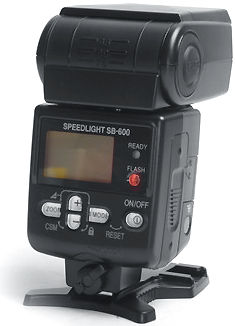 |
|
 |
The SC-24 comes with two TTL multiple flash terminals and one tripod socket. It is approx. 1.5m (4.9 ft.) long. |
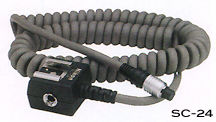 |
TTL Remote Cord SC-24 Use the SC-24 for TTL auto flash operation when using a Speedlight off an F5 fitted with either a 6X High-Magnification Finder DW-31 or Waist-Level Finder DW-30. |
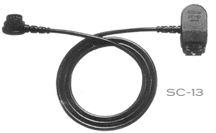 |
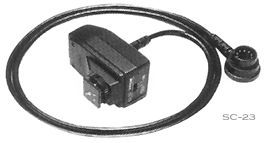 |
TTL Multi-Flash Sync Cords SC-18, SC-19 Use these cords to connect TTL flash units to each other through the TTL Multi-Flash Adapter AS-10 or TTL Remote Cord SC-17 for multi-flash operation. |
TTL Remote
Cord SC-23 Enables off-camera TTL automatic flash control, usable with Nikon
F5, F100, F80 series, F90(x), F70, F601 and F50 and others. SC-12 specifically for
Nikon F3 series only.
TTL Remote Cord SC-24 For TTL flash control when using Nikon F5 and DW-6X
Magnification Finder DW-30 or for TTL flash control when using the Nikon F4-series
with DW-20 or DW-21.
TTL Multi-Flash Adapter AS-10 Attach the AS-1 0 to the SB-28, SB-27, SB-26,
SB-27, SB-22, SB-16B or even a Macro Ringlight SB-21B. Connect additional TTL Speedlight
units with the SC- 18 or SC- 19. The AS-10 controls up to three TTL Speedlight units.
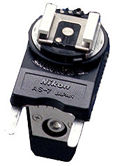 |
|
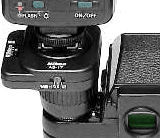 |
AS-15 |
Nikon Flash Coupler / Connectors: |
AS-3 permitting F3-type of flash to be used on Nikon F2 accessory shoe (non-TTL operation, AUTO/MANUAL is possible)
AS-4 provides hot shoe use of ISO-type of flash on any F3 body (except Nikon F3P and Nikon F3H's DE-4, which can mount directly)
AS-5 reverting F2 shoe types of flash units to be used on any standard Nikon F3 accessory shoe in non-TTL operation.
AS-6 converts F3-types of flash foot speedlights to be used on ISO-type of accessory shoe (AUTO/MANUAL is possible, non-TTL operation)
AS-7 Extended from camera body to enable changing film without removing flash. TTL connection maintains with any flash with F3 flash shoe and accepts ISO-type flash units but TTL function is lost (AUTO/MANUAL)
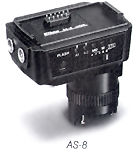 |
 |
AS-8 base unit module for SB-16 for Nikon F3 flash shoe |
AS-10 TTL Multi-Flash Adapter - permits two TTL cords to be connected one another, tripod mount provided.
AS-11 allows Nikon F3 dedicated flash shoe units to be mounted to a 1/4 tripod thread.
AS- 12 SB-21 Controller output unit for the Macro Ringlight SB-21A TTL Macro Speedlight for any standard Nikon F-3 cameras (except F3P and F3H's DE-4, which can mount directly to operate in non-TTL mode via its standard -ISO accessory shoe)
AS-14 SB-21 Controller Unit for ISO-type shoe, options for TTL, AUTO and Manual flash.
AS-15 PC Sync Terminal Adapter for ISO-type shoe: for Nikon SLR that do not have a sync terminal.
AS-16 SK-6 Terminal Adapter (AS-16)
AS-17 allows ISO-type flash with a Nikon F3, TTL, auto and manual flash is possible. This permits all Nikon AF TTL speedlights to be used. The most innovative accessory thus far.
Nikon Flash Bracket SK-6 and/or SK-6A* Nikon has not produced any handle/bracket mount flash since the SB-140UV and so far there isn't such a design available for the AF flash. Well, considering the power output of a modern AF Nikon speedlight is capable to match one of those MF counterpart, Nikon has designed a very usable accessory called SK-6 specifically to be usable with most of the AF speedlights they produced.
 |
 |
A Nikon F4 with SB-26 mounted on a SK-6; another illustration comprises of a SK-6 with SB-28 and a Nikon F90x AF SLR. |
Not only does the SK-6 enable you to use the camera-mountable SB-28 (SB26, SB-25, SB-24) or other flash such as SB-20, SB-22 etc. as a grip-type flash, it also offers you remote-flash capability. Used as an external power source, in combination with the Speedlight own power source, the SK-6 reduces minimum recycling time by about half and doubles the total number of flashes available. It accepts six 1.5V LR6 (AA-type Alkaline), 1.2V KR-AA (AA-type NiCd) or 1.5V FR-6 (AA-type Lithium) batteries It can also be used with the Nikon DC Units SD-7 or SD-8. Note*: According to Nikon, the SK-6A is marketed only in EU countries.
External Power Sources: Nikon DC-Units SD-7* and High Performance Power Pack SD-8/SD-8A**
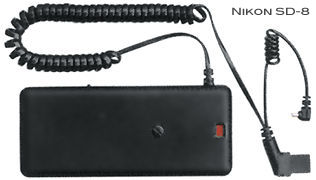 |
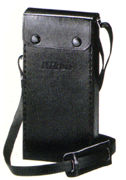 |
DC Unit SD-7 The SD-7 accepts six LR14 (C-type) batteries, and is designed as, a separate power source for the SB-28, SB-26, SB-25, SB-24 and SB-22 and/or other future capable flash models with SK-6 combination. Also usable with MF flash SB-11, SB-14 and SB-140UV. * Not available in EU countries. Pictures not to scales between SD-7 and SD-8. |
high-performance Battery Pack SD-8** The SD-8A is designed for use with the SB-28, SB-27 and/or other future capable flash models while other speedlight SB-28, SB26, SB-25, SB-24 and SB-22 to shorten flash recycling time and enhance flash capacity. It accepts six 1.5v LR6 AA-type alkaline or 1.2v KR-AA (AA-type NiCd) and even accept 1.5v FR6 (AA-type Lithium) batteries. Can be mount at the base of the camera's tripod socket via FM-6 locking screw. This is a more compact and versatile unit than the SD-7 DC power pack.
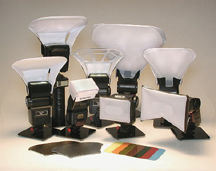 |
Flash Brackets and other third party accessories: I am not sure why photographer needs flash brackets for camera (Since the biggest advantage offers in a SLR camera is mobility and portability). Anyway, in relation to macro works, I may think there is some logic investing into such an accessory. The common brand names associates to this specialize areas are Stroboframes , Stratos Modular Flash Bracket System, Lindahl Specialties Bracket, Custom Brackets, LumiQuest ProMax Bouncers, Ikelite Lite-Link Wireless Slave etc. |
| Previous | Back | 3/3 to Index Page for Flash Photography
Page One | Page Two | Page Three
Relative:
Nikon AF-TTL Speedlight Models: Nikon SB-800 | Nikon SB-600 | Nikon SB-30 | Nikon
SB-29(s)
(2000) | Nikon SB-28 (1997) |
Nikon
SB-27 (1997)
| Nikon
SB-26
(1994) | Nikon SB-25 (1992) |
Nikon
SB-24 (1988) |
SB-23 | SB-22
(1987) |
SB-20 (1986)
Nikon AF-TTL Speedlight DX-Series: Nikon SB-28DX (1999)| SB-50DX (2001) |
SB-80DX (2002)
Additional information on various Nikon MF Bulb Flash - Nikon MF-Speedlights
SB-1 ~ SB-21A/B
| NEXT | Instruction manual (HTML format) - Nikon SB-28 /SB28DX AF-TTL Speedlight(s)
| Back | Main Index Page - Nikon F5 Professional SLR camera
The Camera - Background,
Issues & Summary
Basic
Features | Focusing | Metering Systems | Exposure Control | Reliability Issues | Nikkor lens Compatibility
Prisms/Finders - Index page
- 2 parts
Film Backs: Index
Page - 1 parts
Focusing Screens - Index
Page - 1 part
Flash System - Index
Page
- 3 parts
System Accessories: | Power Sources | Cases | Remote
Control | Miscellaneous
Macro
Photography
- Related info on Micro-Nikkor lenses
Technical Specification for Nikon F5
Main
Reference Map
/ Nomenclature
Resource Centre:
Instruction Manuals
Nikon
F5 Camera Body
- 18
parts
MF-28
Multi-Function Back
HTML - 8
parts
PC
Links - Photo Secretary
- 2
parts
AF-TTL Speedlights:
SB-28 / SB28DX | SB29(s) info | SB30 | SB50DX | SB80DX | SB600 info | SB800
Variants: F5 50th Anniversary Model | Nikon/Kodak DCS-620 | DCS-720 Digital Still SLR camera
| Nikon F | Nikon F2 | Nikon F3 | Nikon F4 | Nikon F5 | Nikon F6 | Nikkormat / Nikomat | Nikon FM | Nikon FE/ FA | Nikon EM/FG/FG20 | Nikon Digital SLRs | Nikon - Other models |
The Eyes of Nikon:-
Nikon Auto Focus Nikkor lenses:- Main
Index Page
Nikon Manual Focus Nikkor lenses:- Fisheye-Nikkor Lenses - Circular | Full Frame |
Ultrawides Lenses - 13mm15mm18mm20mm | Wideangle Lenses - 24mm28mm35mm | Standard Lenses - 45mm 50mm 58mm | Telephoto
Lenses - 85mm105mm135mm180mm & 200mm | Super-Telephoto Lenses - 300mm 400mm 500mm 600mm 800mm 1200mm |
 Index Page |
Special
Application lenses: Micro-Nikkor Lenses - 50mm~55mm -60mm 85mm -105mm 200mm Micro-Zoom 70-180mm Perspective Control (PC) - 28mm 35mm PC-Micro 85mm Dedicated Lenses for Nikon F3AF: AF 80mm f/2.8 | AF 200mm f/3.5 EDIF Depth of Field Control (DC): 105mm 135mm Medical Nikkor: 120mm 200mm Reflex-Nikkor Lenses - 500mm 1000mm 2000mm Others: Noct Nikkor | OP-Nikkor | UV Nikkor 55mm 105mm | Focusing Units | Bellows-Nikkor 105mm 135mm Nikon Series E Lenses: 28mm35mm50mm100mm135mm | E-Series Zoom lenses: 36~72mm75~150mm70~210mm |
MF Zoom-Nikkor Lenses: 25~50mm | 28~45mm | 28~50mm | 28~85mm | 35~70mm | 36~72mm E | 35~85mm | 35~105mm | 35~135mm | 35~200mm | 43~86mm | 50~135mm | 50~300mm | 70~210mm E | 75~150mm E | 80~200mm | 85~250mm | 100~300mm | 180~600mm | 200~400mm | 200~600mm | 360~1200mm | 1200~1700mm
Tele-Converters: TC-1 | TC-2 | TC-200 | TC-201 | TC-300 | TC-301 | TC-14 | TC-14A | TC-14B | TC-14C | TC-14E | TC-16 | TC-16A | TC-20E
Recommended links to understand more technical details
related to the Nikkor F-mount and production Serial Number:
http://rick_oleson.tripod.com/index-153.html by: my
friend, Rick Oleson
http://www.zi.ku.dk/personal/lhhansen/photo/fmount.htm by: Hansen,
Lars Holst
http://www.mir.com.my/rb/photography/hardwares/nikonfmount/lens2.htm
http://www.photosynthesis.co.nz/nikon/serialno.html
| Back | Index Page of Digital
Nikon SLR cameras
|
Back | Main Index Page of Pictorial
History of Nikon SLR cameras
![]()
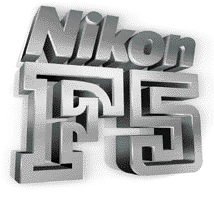 |
| Message Board | for Nikon F5 Series SLR model(s) | |
About this photographic site.
HOME - Photography in Malaysia |
![]()
A resource dedicated to my kids, Alvin Foo & Esther Foo- one day,
BOTH might need to use all these information for his/her Nikon F5A camera.
Volunteered Maintainer(s) for the Nikon F5 Message Board: Tony Davies-Patrick, UK; Rick Oleson, US; Koh Kho King, Malaysia.
Credit: Mr. Chuck Hester, US for his text re-editing skill for this site; Our staff, HowKiat® who created the 3D-Nikon F5 logo. Mr. Lew Chee Wai of YL camera for lending his F5 for me to take some shots appeared in this site. All those nice folks who have contributed their images, in particular Mr. Mike Long, Edwin leong, Palmi Einarsson, Sergio Pessolano, Fred Kamphues, Harry Eggens, Curtis Forrester, Nick (Natures Moments), Sandra Bartocha; fellow countrymen, Vincent Thian, Koh Kho King, Philip Chong, CY Leow etc. and contributions from a few nice folks from Photo Malaysia Forum. Disclaimers & acknowledgments: Certain content and images appeared in this site were either scanned from official marketing leaflets, brochures published by Nikon and/or contribution from surfers who claimed originality of their own work for public publishing in this website, where majority of the extracted information are used basing on educational merits. The creator of this site will not be responsible for any discrepancies that may arise from any possible dispute except rectifying them after verification from respective source. Neither Nikon or its associates has granted any permission(s) in using their public information nor has any interest in the creation of this site. "Nikon", "Nikkormat", "Nippon Kokagu KK" "Silent Wave", "Focus Tracking Lock-on", "Nikkor" & other applicable technical/business terms are registered trade name(s) of Nikon Corporation Inc., Japan. Site made with an Apple G5 IMac.

